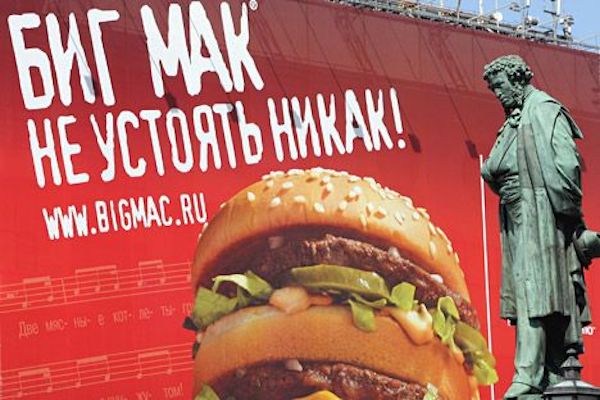Levi’s iconic 501 jeans were one of the most highly coveted symbols of dissent in Russia during the Soviet era. And as the USSR began to crumble, McDonald’s served as a powerful symbol of integration with the West when the company became the country’s first American fast-food restaurant. As both countries now head for the exits, a look back at their histories in the country paints a dramatic picture of how Russia went from global pariah, to a new hope for Democracy, and back again all in just a little over thirty years. Their stories also illustrate the enormous power that a brand can wield even as it might mean very different things to different people.
Levi’s was on the front lines of the Soviet Union’s inner culture war as well as the global Cold war. Levi’s 501s became an accidental sensation behind the Iron Curtain when the United States Information Agency coordinated the American National Exhibition in 1959. According to Levi Strauss & Co., included in the displays of American culture, science, and technology was a booth created by Levi Strauss & Co. filled with 501 jeans and Western-themed advertising. The jeans were so popular that the samples on display had to be replaced almost daily because they were nearly all stolen.
Levi’s jeans were a coveted, but forbidden, capitalist item on the Soviet black market for the next thirty years. Young Russians wanted to look like the film icons and rock stars of the West – and they were willing to pay through the teeth to do so. By 1981, the Soviet Industry newspaper was complaining that their price on the black market had reached an “immoral” 200 roubles, the equivalent of a month’s salary for an average worker. This of course directly conflicted with the Communist Party’s ideology – making jeans would be a response to consumer demand, rather than Party supply, and was thus an insupportably Capitalist undertaking.
To combat this “decline in values,” the Soviets ran propaganda campaigns highlighting poverty and crime in the West. According to Katherine Damm in “The History of Jeans Behind the Iron Curtain,” what really shocked young Russians was that even the homeless people in the West wore jeans, pants which working Russians couldn’t afford. The Financial Times recalled a quote from historian Niall Ferguson – “The Soviets had replicated the atomic bomb but failed to replicate 501s,” from his 2011 book, “Civilization: The West and the Rest,” which identified consumerism as one of the “killer applications” that helped the west prevail.
Russians could finally buy Levi’s at a store inside Russia in 1993. The archive in Levi’s San Francisco headquarters keeps a letter written by a young woman from Moscow, which says: “A man hasn’t very much happy minutes in his life…but the buying of Levi’s jeans (501) is one of such moments in my life.”
McDonald’s entry into the Soviet Union began with a chance meeting. In 1976, McDonald’s loaned some buses to organizers of the 1980 Moscow Olympics who were touring Olympic venues in Montreal. George Cohon, then the head of McDonald’s in Canada, took the visitors to McDonald’s as part of the tour. That same night, the group began discussing ways to open a McDonald’s in the Soviet Union. Fourteen years later, after Soviet laws loosened and McDonald’s built relationships with local farmers, the first McDonald’s opened in downtown Moscow on January 31, 1990. McDonald’s advertised the restaurant’s opening using the slogan: “If you can’t go to America, come to McDonald’s in Moscow.” Behind the scenes, the company received over 27,000 applications for 630 jobs.
Despite the harsh weather, when the restaurant opened at 10 a.m., there was a 500-yard line of customers waiting to get into the 700-seat restaurant, per The Washington Post. The restaurant’s 27 cash registers rang up 30,000 meals on opening day. For many, this was likely their first time trying Western fast food. More importantly, the opening sent a powerful signal to both Russians and the rest of the world that USSR President Mikhail Gorbachev was serious about joining the global economy. For American companies, McDonald’s served somewhat as a litmus test to gauge how hospitable this new Russia would actually be. To Russian and American consumers, McDonald’s was the one common connection between these vastly different cultures, one which represented all the possibilities the world had to offer, the other a failed idea trapped in the past. (Sources: Financial Times, Insider, History, Levi Strauss)








